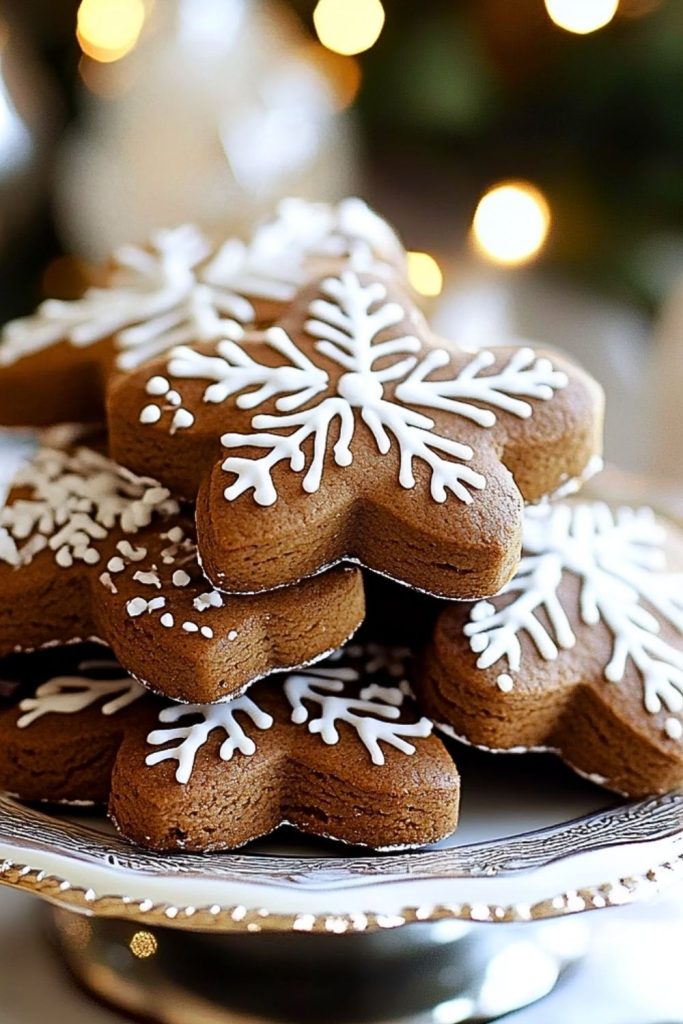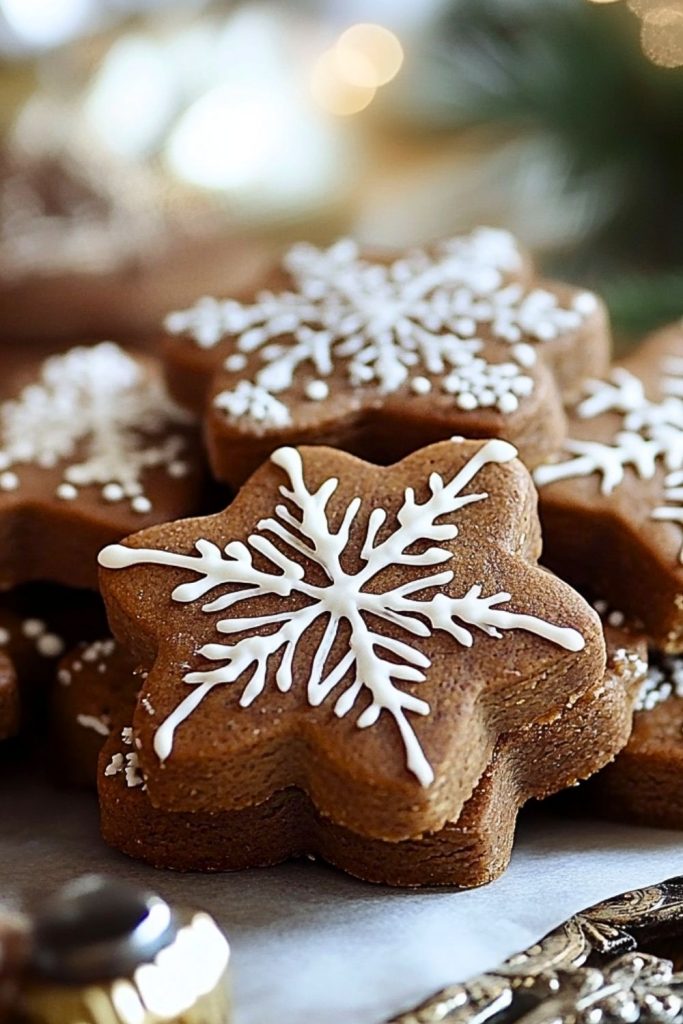Every December, the smell of warm spices begins to fill my kitchen — cinnamon, cloves, nutmeg, and a whisper of ginger wafting through the air like a cozy holiday hug. That’s how I know it’s time to make my favorite holiday treat: Traditional German Lebkuchen. These soft, spiced cookies are more than just festive sweets — they’re tiny bites of nostalgia, each one reminding me of cozy winter markets and twinkling lights.

Lebkuchen is a recipe I’ve come to treasure, not just because it tastes incredible, but because of the joy it brings to anyone who tries it. The dough is rich and fragrant, the icing adds just the right touch of sweetness, and the soft chewiness of each bite makes it feel like you’re indulging in something truly special. Whether you bake them for gifting, serving with hot tea, or leaving out for Santa, they always steal the show.
Why You’ll Love This Traditional German Lebkuchen
If you’re a fan of gingerbread but want something a little more tender, a little more flavorful, Lebkuchen is your answer. It’s warmly spiced but not overpowering, soft with just the right density, and incredibly aromatic thanks to the combination of honey, molasses, and traditional spices. Plus, it keeps beautifully, which makes it ideal for holiday prep and gifting. You’ll also love how the cookies taste even better after a couple of days — the flavors deepen and mellow for that perfect holiday bite.
What Kind of Flour Works Best for Traditional German Lebkuchen?
I’ve tried a few variations over the years, but I always come back to using all-purpose flour. It provides the ideal structure while still keeping the texture soft and cake-like. Some traditional recipes call for rye flour, which gives a deeper, slightly earthier taste — so if you’re feeling adventurous or want to lean more into the old-world flavor, rye is a great option. But if you’re baking these for a crowd, especially for kids, all-purpose flour is a reliable choice that balances flavor and texture just right.
Options for Substitutions
One of the beautiful things about Traditional German Lebkuchen is how flexible it can be with the right tweaks. Can’t find molasses? Dark corn syrup or maple syrup can step in, though you’ll miss some of that classic richness. No ground cloves? Allspice makes a good backup without compromising the spice blend too much. If you need to make these dairy-free, just substitute the butter with plant-based margarine — the cookies will still come out tender and flavorful. For those looking to reduce sugar, you can trim it slightly, but be cautious — the honey and molasses contribute to both flavor and moisture.
Ingredients for This Traditional German Lebkuchen
Honey
Honey is at the heart of Lebkuchen’s flavor. It brings natural sweetness and helps keep the cookies moist and chewy over time.
Brown Sugar
Adds depth and warmth with its molasses content, perfectly complementing the spice blend.
Unsalted Butter
Butter gives the cookies their soft, tender crumb and adds richness to the dough.
Eggs
These bind the ingredients together and give structure to the cookies while keeping them light.
All-Purpose Flour
The foundation of the dough — it provides structure without making the cookies too dense.
Baking Soda
This gives the cookies their gentle lift and keeps them from becoming too flat.
Ground Cinnamon, Cloves, Nutmeg, Ginger, and Allspice
These traditional spices create that warm, spiced profile Lebkuchen is famous for. They’re what make the cookies smell like the holidays.
Salt
Just a pinch enhances all the other flavors and balances the sweetness.
Chopped Nuts (Almonds or Hazelnuts)
Optional but highly recommended. They add a nice texture and a nutty flavor that pairs beautifully with the spices.
Candied Orange or Lemon Peel
For a touch of citrusy brightness that cuts through the warm spices and gives it that unmistakable German character.
Powdered Sugar and Milk (for icing)
Used for the simple glaze that tops each cookie. It adds sweetness and makes them look beautiful and festive.

Step 1: Warm the Honey, Sugar, and Butter
In a medium saucepan, combine the honey, brown sugar, and butter. Heat over low to medium heat, stirring occasionally, until everything is melted and smooth. Don’t let it boil — just warm it enough to blend. Remove from heat and let it cool slightly before continuing.
Step 2: Stir in the Spices and Eggs
Once the mixture is warm but not hot, stir in your ground spices: cinnamon, cloves, nutmeg, ginger, and allspice. Add a pinch of salt for balance, then beat in the eggs one at a time until well incorporated.
Step 3: Add the Dry Ingredients
In a large mixing bowl, combine the flour and baking soda. Gradually add the flour mixture to the wet ingredients, stirring just until a dough forms. If using chopped nuts or candied peel, fold them in at this stage.
Step 4: Chill the Dough
Cover the dough and refrigerate it for at least 2 hours, or overnight if you can. This firms it up and allows the flavors to meld beautifully.
Step 5: Roll and Cut
Preheat your oven to 350°F (175°C). Roll out the dough on a lightly floured surface to about 1/4 inch thick. Use cookie cutters (traditional hearts, stars, or festive shapes) to cut out your cookies. Transfer them to a parchment-lined baking sheet.
Step 6: Bake
Bake the cookies for 10–12 minutes, just until the edges are set and the tops look dry. They’ll firm up more as they cool, so avoid overbaking.
Step 7: Ice and Decorate
Once the cookies have completely cooled, whisk together powdered sugar and a bit of milk to make a smooth glaze. Drizzle or pipe it over the cookies — simple stripes or snowflake patterns look lovely and traditional.
How Long to Cook Traditional German Lebkuchen
Lebkuchen cookies typically bake for 10 to 12 minutes in a preheated 350°F (175°C) oven. You’ll know they’re ready when the edges feel set, but the centers are still slightly soft. Keep in mind, they’ll continue to firm up as they cool on the tray — that’s what gives them their signature chewy texture. If you prefer them a little firmer, go for the full 12 minutes, but don’t overbake or they’ll lose that tender bite.
Tips for Perfect Traditional German Lebkuchen
- Chill the dough well. This helps keep the cookies from spreading too much and makes it easier to cut clean shapes.
- Use fresh spices. Ground spices lose potency over time. For the boldest flavor, use spices that haven’t been sitting in your pantry too long.
- Don’t skip the cooling. Let the cookies cool fully before icing. Otherwise, the glaze will melt and slide right off.
- Add citrus zest. If you’re not using candied peel, grated lemon or orange zest adds that same burst of brightness.
- Store for flavor. These cookies actually taste better after a day or two — the spices mellow and mingle, becoming even more delicious.
- Don’t overcrowd the pan. Give them room to breathe on the baking sheet so they bake evenly.
- Try royal icing for a crisp finish. If you want more defined designs or longer shelf life, go with royal icing instead of glaze.
- Use a nonstick rolling mat or parchment. This keeps the dough from sticking without the need for too much flour, which can dry out the cookies.
Watch Out for These Mistakes While Cooking
Even with a time-honored recipe like Traditional German Lebkuchen, a few common missteps can sneak in. Here’s what to look out for:
- Overheating the honey mixture – If it boils, it can affect the dough’s texture and make the cookies hard rather than tender.
- Skipping the chilling step – The dough is too soft to handle when warm, and skipping the chill leads to misshapen cookies.
- Overbaking – Lebkuchen should be soft. If they’re golden brown on top, they’ve likely gone too far. Pull them just when the edges are set.
- Using too much flour while rolling – This can dry the dough out. A light dusting is all you need.
- Not measuring spices properly – Go light-handed if you’re unsure. Too much clove or allspice can overpower everything.
- Icing warm cookies – The glaze won’t set and can melt into the cookie, leaving a sticky mess.
- Forgetting to preheat the oven – That initial burst of heat helps the cookies hold their shape.
- Using old baking soda – If your baking soda is expired, the cookies may turn out flat or dense instead of soft and pillowy.
What to Serve With Traditional German Lebkuchen?
1. Hot Mulled Wine (Glühwein)
A classic holiday pairing — the warm spices in the drink complement the cookie beautifully.
2. Coffee or Espresso
The bitterness of coffee balances the sweetness of the Lebkuchen for an afternoon treat.
3. Black Tea with Lemon
A gentle, citrusy tea brings out the hints of candied peel in the cookies.
4. Hot Chocolate
Creamy and rich, hot chocolate makes this feel like the coziest dessert duo.
5. Vanilla Ice Cream
A scoop of cold, creamy vanilla next to a warm cookie? Heavenly contrast.
6. Apple Cider (Warm or Cold)
Spiced cider echoes the cookie’s warmth while adding a fruity twist.
7. Whipped Cream or Sweetened Mascarpone
A small dollop adds a luxurious touch if you’re serving the cookies plated.
8. A Dessert Board with Cheese and Fruit
Serve Lebkuchen alongside mild cheeses, grapes, figs, and nuts for an elegant holiday board.
Storage Instructions
Traditional German Lebkuchen actually gets better with time, which makes storage a breeze. Once the cookies have completely cooled and the icing has set, place them in an airtight container. They can be stored at room temperature for up to 2 weeks, and the flavor only deepens as they rest. For even better results, add a slice of apple or a piece of fresh orange peel (wrapped in parchment) to the container to help keep the cookies moist.
If you’d like to store them longer, freeze un-iced cookies in an airtight container or freezer-safe bag for up to 3 months. Just thaw at room temperature and ice once they’re fully defrosted.
Estimated Nutrition
Here’s a general idea for the nutrition of one medium Lebkuchen cookie (about 2.5–3 inches wide). Keep in mind this varies depending on size and icing:
- Calories: ~130
- Carbohydrates: ~22g
- Sugars: ~13g
- Fat: ~4g
- Saturated Fat: ~2g
- Protein: ~2g
- Fiber: ~1g
- Sodium: ~60mg
These are modest in size but packed with flavor — just the way a holiday treat should be!
Frequently Asked Questions
How long do Lebkuchen cookies last?
They keep beautifully for up to 2 weeks at room temperature in an airtight container. In fact, the flavor improves with time.
Can I freeze Lebkuchen?
Yes! Freeze un-iced cookies for up to 3 months. Thaw completely at room temperature before icing and serving.
Can I make the dough ahead of time?
Absolutely. You can make the dough and refrigerate it for up to 3 days before baking. You can also freeze the dough for future use.
Is Lebkuchen the same as gingerbread?
Not quite. While both are spiced, Lebkuchen is softer, chewier, and often includes nuts and citrus peel for a more complex flavor.
Can I make Lebkuchen without nuts?
Definitely. Just leave them out — the cookies will still be delicious and maintain their texture.
Why do the cookies taste better after a day or two?
The spices need time to meld. Letting the cookies rest enhances the flavor, giving them a richer, more aromatic taste.
What’s the best icing to use?
A simple glaze made with powdered sugar and milk works perfectly. For sharper detail, try royal icing.
Can I make this gluten-free?
Yes, you can try using a gluten-free all-purpose flour blend. The texture may be slightly different, but the flavor will still shine.
Conclusion
Traditional German Lebkuchen is one of those magical recipes that brings warmth and joy to any kitchen. It’s steeped in history, wrapped in nostalgia, and filled with comforting spices that make you feel like you’re standing in the middle of a festive holiday market. Whether you’re gifting them, sharing with family, or simply enjoying them with a cup of tea, these cookies are a celebration of winter’s coziest flavors. Once you bake a batch, I have a feeling they’ll become part of your own holiday traditions too.

Traditional German Lebkuchen
- Prep Time: 20 minutes
- Chill Time: 20 minutes
- Cook Time: 10 minutes
- Total Time: 50 minutes
- Yield: 24 cookies 1x
Description
Warm spices, soft texture, and nostalgic charm — Traditional German Lebkuchen is the ultimate holiday cookie. Perfect for anyone looking for easy dessert ideas, holiday baking recipes, or a festive homemade gift, these cookies combine cinnamon, cloves, and honey into chewy, beautifully iced treats. Whether you’re after a quick baking project, a cozy winter snack, or something to impress on a dessert table, Lebkuchen delivers every time. The comforting aroma and soft bite will make this your go-to Christmas cookie recipe.
Ingredients
- 1/2 cup honey
- 1/2 cup brown sugar
- 1/4 cup unsalted butter
- 1 large egg
- 1 3/4 cups all-purpose flour
- 1/2 tsp baking soda
- 1 tsp ground cinnamon
- 1/4 tsp ground cloves
- 1/4 tsp ground nutmeg
- 1/2 tsp ground ginger
- 1/4 tsp allspice
- 1/4 tsp salt
- 1/4 cup chopped nuts (optional)
- 1/4 cup candied orange or lemon peel (optional)
- 1 cup powdered sugar
- 2–3 tbsp milk (for icing)
Instructions
- In a saucepan, gently heat honey, brown sugar, and butter until melted and smooth. Let cool slightly.
- Stir in spices and salt, then beat in the egg.
- In a separate bowl, whisk together flour and baking soda.
- Add dry ingredients to the honey mixture and mix until combined.
- Fold in nuts and candied peel, if using.
- Cover and refrigerate dough for at least 2 hours or overnight.
- Preheat oven to 350°F (175°C). Roll dough to 1/4 inch thick and cut into desired shapes.
- Place cookies on parchment-lined baking sheets and bake for 10–12 minutes.
- Let cookies cool completely.
- Mix powdered sugar and milk to make a glaze. Decorate cookies as desired.

